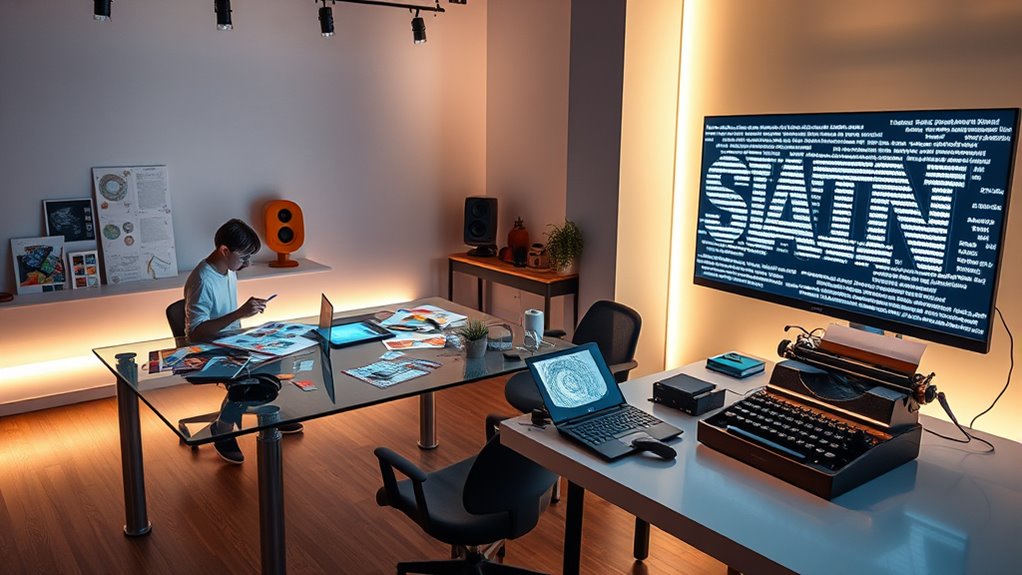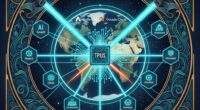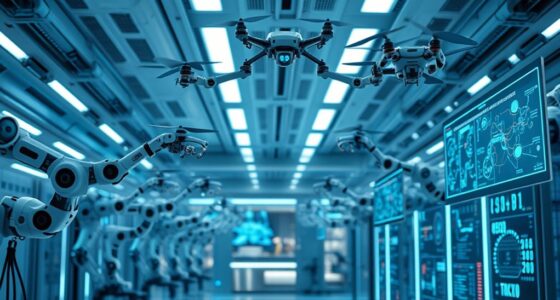AI is revolutionizing creative work by enabling designers and writers to innovate faster, automate routine tasks, and produce higher-quality content with ease. Generative tools like Midjourney, DALL·E, ChatGPT, and others help you generate images, scripts, and visuals instantly, boosting efficiency and inspiring new ideas. As AI adoption grows, it’s transforming workflows and collaboration. To understand how these advances can elevate your projects, explore what’s shaping this industry today.
Key Takeaways
- Designers and writers are rapidly adopting AI-powered tools like Midjourney, DALL·E, and ChatGPT to streamline their workflows.
- Generative AI enables quick creation of visuals and content, reducing production time and costs for creative projects.
- AI facilitates collaboration through shared assets, real-time editing, and virtual assistants, enhancing team efficiency.
- Creative professionals use AI for ideation, drafting, and refining work, expanding artistic possibilities and experimentation.
- Ethical considerations such as intellectual property and transparency are increasingly addressed as AI tools become integral to creative work.
The Rise of AI Adoption Among Creatives

Have you noticed how AI has become an integral part of creative work? Today, over 80% of content creators use AI in some way, with nearly 39% relying on it throughout their entire workflow. Video creators lead the charge, surpassing text, visual, and audio creators in AI adoption. Every day, around 34 million AI-generated images are produced, revolutionizing marketing and design practices. The rapid growth of generative AI tools—more than 4,800 launched in 2025 alone—reflects how quickly the industry is evolving. As AI becomes more accessible, it’s reshaping how creators ideate, produce, and collaborate. The increasing importance of carrier oils in supporting safe and effective use of essential oils demonstrates how foundational knowledge can enhance creative applications. This widespread adoption underscores AI’s essential role in enhancing efficiency, expanding creative possibilities, and transforming traditional workflows across all creative disciplines.
Key Tools Transforming Artistic and Writing Processes

Among the many AI tools revolutionizing creative workflows, platforms like Midjourney, DALL·E, ChatGPT, and Adobe Firefly stand out for their impact on artistic and writing processes. These tools streamline your work by automating tasks and expanding creative possibilities. For example:
AI tools like Midjourney, DALL·E, ChatGPT, and Adobe Firefly are transforming creative workflows by automating tasks and expanding possibilities.
- AI Image Generators: Midjourney and DALL·E enable you to create stunning visuals from text prompts, speeding up concept development.
- Writing Assistance: ChatGPT helps craft drafts, brainstorm ideas, and refine language, enhancing productivity.
- Design and Content Tools: Adobe Firefly produces billions of images, while Jasper and Copy.ai assist in marketing copy and storytelling.
- Understanding the importance of color accuracy can help you produce more visually appealing and realistic images and designs.
Together, these tools transform your workflows, allowing rapid experimentation, increased creativity, and more efficient project completion.
How AI Accelerates Creative Workflows

AI transforms creative workflows by automating time-consuming tasks like brainstorming, drafting, and visual design, allowing you to focus more on your core ideas. Instead of spending hours generating initial concepts, you can use AI tools to quickly produce multiple options, saving valuable time. For writers, AI accelerates content creation by suggesting outlines, refining language, and generating drafts in seconds. Visual artists leverage AI to test different styles and compositions instantly, reducing the need for lengthy revisions. Video creators can script scenes and generate visual assets faster, streamlining production. AI also enables rapid iteration, helping you experiment with ideas without the constraints of traditional constraints or resource limitations. Additionally, understanding the health benefits of natural products can inspire creative concepts for wellness-related content, making your work more engaging. This acceleration boosts productivity, letting you bring projects to completion more efficiently and creatively.
Impact of Generative AI on Visual and Text Content
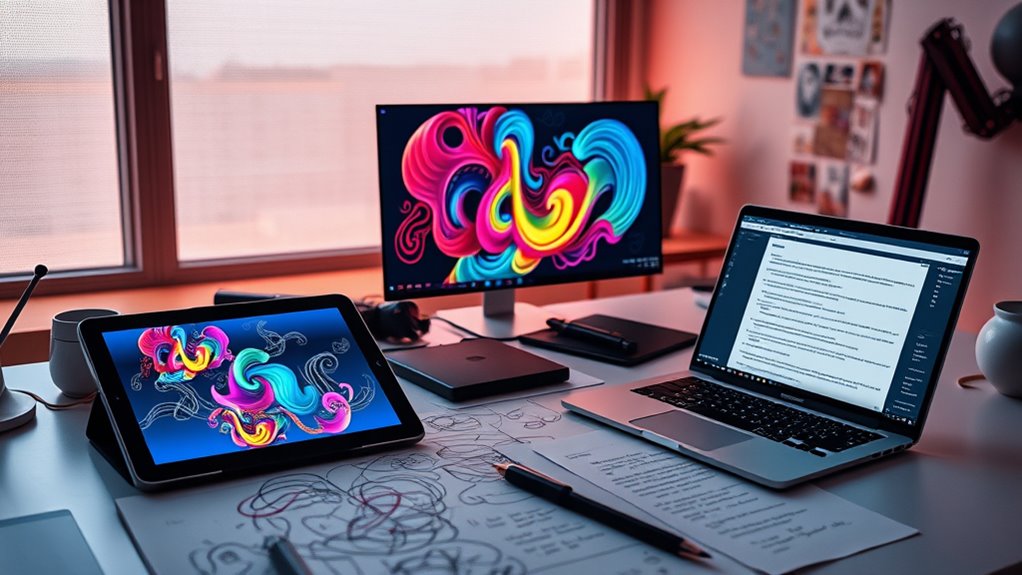
Generative AI is revolutionizing how visual and text content is created, offering tools that enable you to produce high-quality assets rapidly and at a lower cost. It allows you to generate diverse images, videos, and written material, transforming your creative process. With these tools, you can:
- Quickly produce multiple visual concepts or drafts without costly shoots.
- Automate content ideation, scripting, and editing for faster turnaround.
- Scale content creation effortlessly, maintaining consistency across projects.
- The use of high-pressure application in tools like AI-generated art helps achieve more detailed and refined results quickly.
This shift means you can experiment more freely, refine ideas swiftly, and meet tight deadlines with ease. AI-driven platforms like Midjourney and ChatGPT help you enhance your work, making creativity more efficient and accessible. As a result, the landscape of visual and text content is more dynamic and adaptable than ever.
Market Trends and Future Growth Opportunities

The market for creative AI tools is expanding rapidly, driven by increasing investments and technological advancements. You’ll see new tools emerging daily, with over 13 launched each day, fueling innovation across creative fields. The global generative AI market grew from $29 billion in 2022 to nearly $45 billion in 2025, and it’s projected to hit over $66 billion by the end of this year. Long-term, forecasts suggest the market could reach $1.3 trillion by 2032, with software revenue growing at a 42% CAGR. North America leads the charge, holding over 40% of the revenue share. Opportunities abound for creators willing to adopt these tools, as they continue to reshape workflows, enhance collaboration, and access new levels of creativity across industries.
Influences on Collaboration and Team Projects
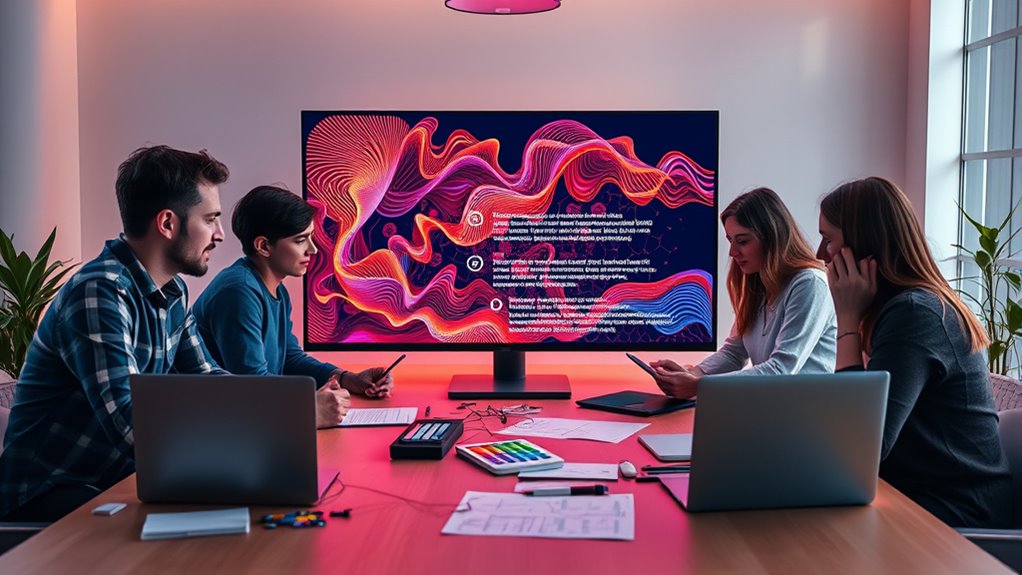
AI tools are transforming how teams work together by streamlining workflows and reducing manual tasks. Shared creative resources allow team members to collaborate more efficiently and stay aligned on projects. As a result, collaboration becomes faster, more organized, and better suited to meet tight deadlines. Additionally, participating in hackathons can further enhance team innovation and problem-solving skills through collaborative, time-bound challenges.
Streamlined Team Workflows
Streamlined team workflows are transforming how creative projects come together by enabling faster collaboration and more efficient resource sharing. AI tools help you coordinate tasks, reduce bottlenecks, and keep everyone aligned. Here’s how:
- Centralized Platforms: AI-powered collaboration platforms consolidate assets, feedback, and updates, making it easier to track progress.
- Real-Time Communication: AI-driven chatbots and virtual assistants facilitate instant communication, preventing delays and misunderstandings.
- Automated Task Management: AI automates scheduling, deadline tracking, and resource allocation, ensuring projects stay on schedule.
- Flexible Hours: Many retail locations, such as Game Cameron Toll and Joanns Craft Store, offer extended hours during busy periods to support team schedules and project deadlines.
These innovations cut down on manual coordination, allowing your team to focus on creative growth. As a result, projects move faster, collaboration improves, and resources are optimized for maximum impact.
Shared Creative Resources
How do shared creative resources reshape collaboration in team projects? They centralize assets, making ideas accessible and editable for everyone. This fosters real-time feedback, reduces duplication, and speeds up workflows. When teams use shared AI-generated images, scripts, or design templates, consistency improves, and the creative process becomes more cohesive. These resources break down silos, enabling diverse team members to contribute seamlessly. As a result, projects stay aligned, and innovation accelerates. Incorporating design elements that reflect the farmhouse aesthetic can also inspire fresh ideas and enhance team synergy.
Enhanced Collaborative Efficiency
Shared creative resources empower teams to work more efficiently by providing centralized assets that everyone can access, edit, and update in real time. This streamlines collaboration, reduces version conflicts, and accelerates project timelines. Generative AI tools enhance this process by enabling rapid sharing and iteration. Specifically, they:
- Facilitate seamless communication with shared prompts and outputs.
- Enable real-time editing of visual and textual content across team members.
- Automate repetitive tasks, freeing your team to focus on strategic decisions.
- Incorporate legal guidelines, such as content licensing, to ensure proper use and attribution of shared assets.
Challenges and Ethical Considerations in AI-Generated Content
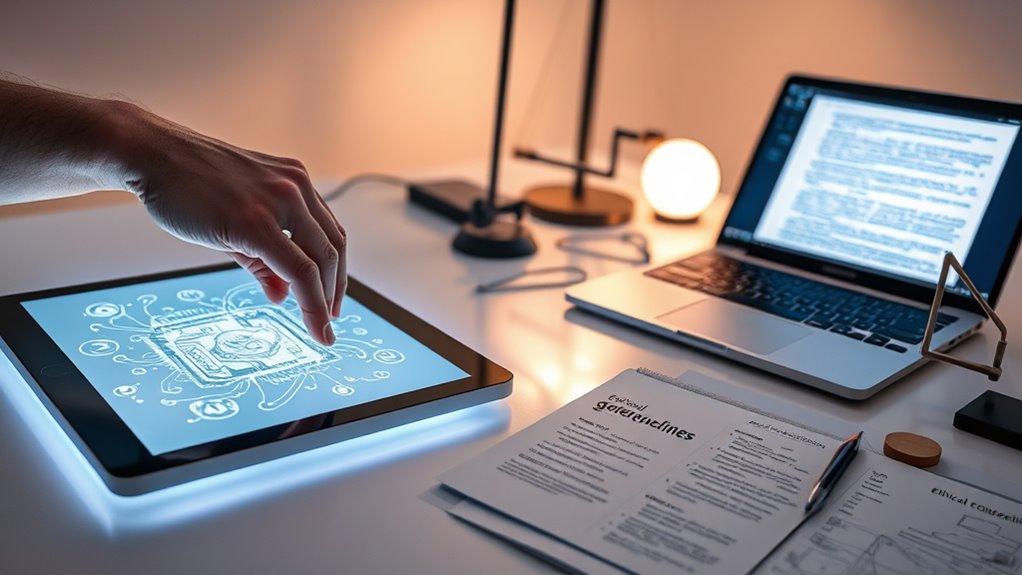
As AI-generated content becomes more prevalent in creative industries, significant challenges and ethical concerns arise. You must address issues like intellectual property, originality, and bias. AI tools can unintentionally replicate biases present in training data, leading to unfair or harmful outputs. Additionally, questions about authorship and ownership emerge when machines generate work. Transparency is *vital*; audiences deserve to know if content is AI-created. Here’s a quick overview:
| Challenge | Ethical Considerations |
|---|---|
| Intellectual property rights | Ensuring fair attribution and licensing |
| Bias and fairness | Avoiding harmful stereotypes |
| Authenticity and transparency | Maintaining trust with audiences |
Navigating these concerns is essential to responsibly harness AI’s creative potential. AI Security considerations highlight the importance of ongoing monitoring to prevent misuse and mitigate potential risks.
Real-World Examples of AI in Design and Writing

Have you noticed AI transforming creative processes in real-world projects? You see it daily in diverse ways:
- Designers use tools like Midjourney and DALL·E to generate unique images instantly, speeding up concept development.
- Writers rely on ChatGPT and Jasper to brainstorm ideas, draft articles, and refine content efficiently.
- Marketing teams create thousands of AI-generated images daily, shaping visual campaigns without expensive photoshoots.
- Awareness of store hours helps creators plan their work schedules around retail availability, ensuring access to resources and inspiration.
These examples show AI not only accelerates workflows but also expands creative possibilities. For instance, architecture firms use AI to visualize concepts faster, while authors craft story prompts with AI assistance. Across industries, AI tools streamline processes, reduce costs, and inspire innovation—making them essential in modern creative work.
Looking Ahead: Emerging Technologies and Long-Term Outlook

As AI technology continues to accelerate, you’ll see new tools emerging rapidly, shaping creative workflows in ways we haven’t yet imagined. At the same time, evolving ethical standards will influence how you use and trust AI-generated content. Market expansion trajectories suggest that, over the coming years, AI’s role in creative work will become even more integral and widespread.
Accelerating AI Innovation
Emerging technologies are driving rapid advancements in AI, promising to reshape creative workflows even further. You’ll see innovations accelerate as new tools and models emerge daily, boosting productivity and creativity. Here are three ways this innovation unfolds:
- Increased automation of routine tasks, freeing you to focus on strategic and creative decisions.
- Enhanced real-time collaboration through smarter, integrated platforms that streamline team workflows.
- Development of more sophisticated generative models that produce higher-quality content, closer to human creativity.
These advancements will make AI more intuitive and accessible, enabling you to experiment and refine ideas faster than ever before. As AI innovation accelerates, you’ll find your creative process becoming more dynamic, efficient, and responsive to evolving demands.
Evolving Ethical Standards
With the rapid growth of AI in creative work, ethical standards must develop to address new challenges and responsibilities. As AI tools generate content at an unprecedented scale, issues like authorship, copyright, and bias become critical. You need clear guidelines to ensure responsible use, protect creators’ rights, and maintain public trust.
| Aspect | Concern | Action Needed |
|---|---|---|
| Authorship | AI-generated content attribution | Establish policies for credit and transparency |
| Copyright | Intellectual property rights | Clarify ownership and licensing frameworks |
| Bias & Fairness | Algorithmic biases affecting outputs | Regular audits and diverse training data |
| Transparency | Openness about AI use | Disclose AI involvement in creative processes |
| Legal Compliance | Adherence to evolving regulations | Stay updated on legal standards and policies |
You are trained on data up to October 2023.
Market Expansion Trajectories
The future of AI in creative markets hinges on the rapid development of new technologies and expanding applications that push current boundaries. You’ll see market growth driven by innovations in AI tools, increased adoption across industries, and expanding use cases. As the market approaches $66.62 billion by 2025 and potentially $1.3 trillion by 2032, you’ll notice three key trajectories:
- Continued proliferation of AI tools, with over 13 new tools introduced daily, broadening creative options.
- Greater industry integration, especially in North America, maintaining its dominant share.
- Rising investments fueling infrastructure development, enabling more sophisticated and accessible applications.
These trends will reshape workflows, open up new creative possibilities, and challenge existing industry standards.
Frequently Asked Questions
How Do AI Tools Affect Intellectual Property Rights?
AI tools complicate your intellectual property rights because they often generate content based on existing works, raising questions about originality and ownership. When you use AI, you need to understand licensing agreements and how rights are transferred or shared. Be cautious about copyright laws, as AI-generated content may not automatically be protected, and you could face legal disputes over who owns the rights to the work.
What Skills Are Essential for Creators Using AI?
You need to develop technical skills like mastering AI tools and understanding their functionalities. Creative skills, such as visual design, storytelling, and editing, remain essential to add originality and context. Critical thinking helps you evaluate AI outputs for quality and legality. Staying updated on ethical issues and licensing guarantees responsible use. Flexibility and adaptability are crucial as AI tools evolve rapidly, enabling you to integrate new features seamlessly into your workflow.
Are There Legal Risks in Using Ai-Generated Content?
While AI-generated content offers exciting possibilities, you should be aware of subtle legal pitfalls. You might unintentionally infringe on copyrights, especially if the AI uses protected material without proper licensing. It’s wise to verify licensing terms, understand intellectual property laws, and be cautious with source material. Staying informed helps you navigate potential legal gray areas smoothly, ensuring your creative pursuits remain both innovative and compliant.
How Do AI Tools Impact Job Opportunities in Creative Fields?
AI tools open new job opportunities in creative fields by enabling you to work faster, produce more innovative content, and explore new formats. They help you collaborate more effectively and handle repetitive tasks, freeing you to focus on higher-level creativity. While some roles may evolve or shift, embracing AI can make you more competitive and adaptable, ultimately expanding your career options rather than limiting them.
What Are the Best Practices for Ethical AI Use in Creativity?
You must prioritize transparency, always disclose AI’s role in your work, no matter how small. Respect copyright laws, never steal ideas, and give credit where it’s due. Stay informed about ethical guidelines, avoid bias, and guarantee your AI-generated content is authentic and fair. By doing so, you not only protect your reputation but also help shape a trustworthy, innovative creative industry where humans and AI collaborate ethically and responsibly.
Conclusion
As you explore AI’s role in creative work, remember it’s like Pandora’s box—full of potential yet demanding responsibility. Embrace these tools to open new domains of innovation, but stay mindful of ethical boundaries. Just as Da Vinci pushed artistic limits, your mastery will define how AI shapes the future of design and writing. In this evolving landscape, your choices echo the timeless dance between human intuition and technological transformation.
